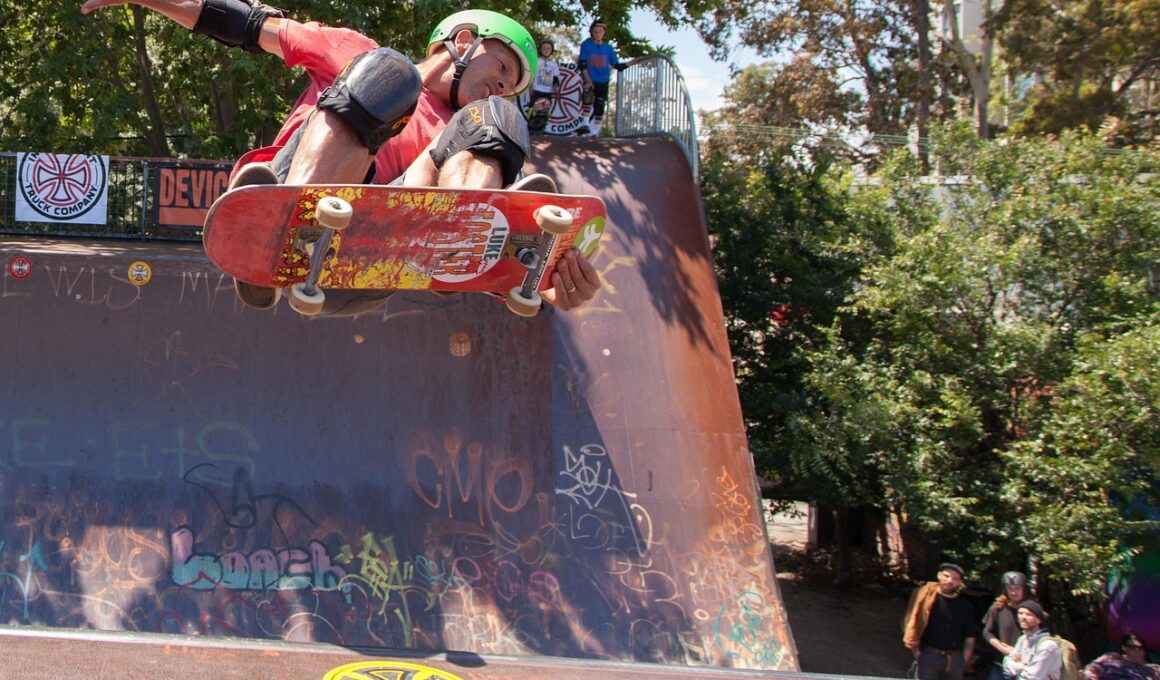Skateboard Ramps and Rails: Equipment Reviews for Building Your Park
Creating a skateboarding park requires careful consideration of various equipment to ensure safety and enjoyment. One of the foundational elements are skateboard ramps and rails. These essential components come in various styles and designs, catering to different skill levels from beginners to advanced skaters. Selecting the right ramps and rails can significantly enhance the overall skateboarding experience, allowing for creative tricks and fun sessions. Various brands specialize in high-quality materials, ensuring durability and safety features appropriate for public spaces. When investing in equipment, proper research on the materials used is crucial. Moreover, consider the overall design of the ramps to ensure they suit your park layout effectively. For instance, if you have limited space, portable ramps might be an ideal solution. Safety is paramount; thus, it is highly recommended to check if safety features are integrated into the design, such as rounded edges and skid-resistant surfaces. Furthermore, maintenance is an important aspect of ramps and rails, so choosing equipment that is easy to clean and maintain can save a lot of hassle in the long run. Always prioritize safety and enjoyment when building your ideal skate spot.
When selecting skateboard ramps, there are a few types you might want to consider that cater to various skill levels. For beginners, a funbox might be a great choice, offering various features on one structure. This type usually includes a box, rails, and ledges, allowing newbies to practice tricks safely. For skaters looking to advance their skills, a quarter pipe could provide the perfect opportunity to practice vert tricks and develop confidence. Keep in mind that the height and slope of your ramps should correspond to the user’s ability. Other shapes, such as half pipes, also offer exhilarating experiences mainly designed for more advanced riders. Depending on your park’s dynamics, you might include mini ramps for a laid-back feel. Choosing durable materials for your ramps, such as treated plywood or steel, ensures longevity and performance during skating sessions. Another factor to consider is the connection of ramps to the terrain; they should be securely anchored without wobbling. To easily share your experiences with others, it is beneficial to have detailed reviews and photographs on social media, showcasing your park’s unique setup.
Understanding Skate Park Design
Designing a skate park includes understanding how specific equipment, such as rails, can affect the skating experience. Rails come in various heights and widths, which can cater to distinct tricks. A common type is the flat rail, known for its versatility, perfect for grinds, slides, and other tricks. For more advanced skaters, having a round rail or a kinked rail can provide challenging opportunities to test skills. A rail’s height directly impacts the level of difficulty for tricks; thus, ensuring a variety of height options can accommodate all-level skaters. In addition, the rail surface should be even and smooth for better sliding, which guarantees that skaters will safely execute their tricks. There is also a need to ensure that your chosen rails are corrosion-resistant, especially if your park is outdoors. Consider the park’s overall flow; positioning rails next to ramps can create seamless transitions. Furthermore, providing ample space between ramps and rails is crucial for safety to prevent collisions. Regular inspections of the assembly and stability of rails ensure long-lasting enjoyment for skaters in your park. Well-designed parks can be a great hub for the skating community.
When integrating skateboard equipment into your park, it is vital to consider user groups and their needs. Young skateboarders may need specially-designed equipment that’s not only safe but also accessible. Equipment such as smaller ramps or specialized rails with softer edges can create a welcoming atmosphere for these beginner skaters. Not only does this allow them to build confidence, but it also encourages community participation. Hosting events focused on nurturing new talent can promote a culture of safety and creativity within the skateboarding community. Furthermore, you may want to implement a designated area for more advanced skaters, like larger ramps and technical rails, ensuring that everyone has a space to enjoy skating. Building separate sections allows both beginners and advanced skaters to enjoy their time without disruptions. The overall design should emphasize flow within the park to facilitate friendly interaction among skaters. Implementing elements such as benches or shaded seating can allow spectators and other visitors to comfortably watch the skating activities. Additionally, dynamic layouts with various structures create a visually appealing park environment that draws people in and provides endless fun for everyone.
Choosing the Right Material for Equipment
When deciding on materials for fun skateboarding ramps and rails, durability and maintenance should be high on your list. Terrain-responsive materials like concrete and metal can withstand intense use and adverse weather conditions. Concrete ramps, for instance, provide a solid foundation for all types of tricks and require low maintenance once established. On the other hand, metal rails can provide a reliable surface for sliding while maintaining their shape and integrity over time. When constructing wooden ramps, utilize high-quality plywood that’s treated for weather resistance. It’s crucial to apply sealants to protect the wood from moisture. Additionally, consider using heavy-duty coatings on rails to reduce friction and increase sliding performance. It is advisable to prioritize non-slip finishes for ramps. This prevents any skateboarding accidents, especially in wet conditions. Furthermore, be conscious of your color choices; bright colors can attract attention and add excitement to the park’s aesthetic appeal. Another aspect is ensuring that the materials do not compromise the safety of the skaters using them. Opting for high-quality materials will ultimately lead to a better experience for all users.
As you finalize your skate park, consider integrating various additional features like obstacles and benches. Adding features, such as bumps or boxes, promotes creativity and gives skaters the chance to showcase their skills. Obstacles like hubs can allow for creative trick variations, adding to the unique flair of your park. Benches or picnic tables can offer a social space for skaters and spectators, enhancing community engagement. Consider the layout carefully so that all equipment has a purpose and flows well with one another. A well-structured design encourages skaters of all levels to enjoy themselves while staying safe. It’s vital to obtain feedback from the skating community to ensure that the park meets everyone’s needs. This involvement can lead to thoughtful suggestions about specific features or improvements. Furthermore, engaging the community in events and competitions can foster connections and camaraderie among skaters. Local skate shops often provide invaluable sponsorship, which can help in funding attractive features. Always strive for an inclusive environment where everyone feels welcome, and ensure that all equipment represents the various interests within your skateboarding community.
Maintenance of Your Skateboarding Equipment
Proper maintenance of skateboard ramps and rails is essential for the continued enjoyment and safety of all users. Regular inspections allow you to identify issues like wear and tear, rust patches, or any structural weaknesses. Addressing these problems quickly can prevent accidents and injuries, ensuring that skaters always have a safe environment. It’s also beneficial to clean ramps and rails periodically to prevent dirt buildup, which can lead to slipping hazards. Checking the surfaces for cracking or splintering will help preserve the integrity of the equipment. Make sure to apply protective coatings that may extend the lifespan of exposed wood or metal surfaces. Keeping a proper maintenance schedule will help to gauge when repairs or replacements are needed. Additionally, involving the skating community in maintenance efforts can foster teamwork and ownership among users. Organizing volunteer days not only keeps the park in good condition but also strengthens community ties. Lastly, always promote safety guidelines associated with equipment use, ensuring that every skater understands the importance of maintaining an excellent skating environment.
In conclusion, building an amazing skateboard park relies heavily on the quality of ramps and rails you choose to incorporate. Prioritizing safety, accessibility, and efficiency can create a welcoming environment that fosters creativity within the skating community. It’s imperative to engage with local skaters, discerning their desires and recommendations on equipment and layout for optimal satisfaction. Various features, such as rails of different shapes and sizes or ramps designed for all experience levels, can enhance the overall atmosphere of your park. Moreover, considering the materials chosen will impact not only the look but also the durability of the equipment. Integrating a maintenance plan and community involvement will help keep the park functional and engaging for everyone. Remember, a well-designed skate park is not only a space for practicing skills but also a hub for social interaction within the local skateboarding culture. Striving for quality in both construction and design will ensure that both beginners and expert skaters find pleasure in your park facilities. Documenting progress and improvements online can inspire and attract others in the community who may want to join or visit your park.


